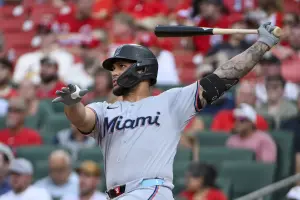
(*) ROTISSERIE: Statcast surgers, 2019
This article appeared in the June 19th issue of Sports Weekly.
The Statcast metrics on batted balls collected by Major League Baseball can help to validate the quick or slow starts shown by hitters. They can also help us predict future changes in a batter’s production output.
As such, here are several hitters worth targeting based upon an early look at their batted ball metrics.
AMERICAN LEAGUE
Backstop Gary Sánchez (C, NYY) is putting his rough 2018 season behind him. He already has hit more home runs this season than he did all of last year. He is “barreling” (a description for batted balls hit with an optimal exit velocity and launch angle) his batted balls at a percentage higher than any other hitter not named Gallo. Likewise, he has increased his barrel percentage from last season more than any bat in the game. In addition, Sanchez’s average exit velocity has jumped by 3 mph. And those gains have come without any erosion in his strikeout rate. Expect Sanchez to set a new career high in home runs this season.
Former top prospect Yoán Moncada (3B, CHW) is another pre-peak bat that has added nearly 3 mph of exit velocity so far in 2019. He is also barreling balls at a much higher rate than he did last season. Those gains support the growth he has shown in both his batting average and power. In addition, Moncada is striking out at his lowest rate ever. The missing piece preventing him from joining the game’s elite can be found in his struggles against left handed pitching. Once he figures them out, Moncada will be a legitimate cornerstone bat.
Rafael Devers (3B, BOS) is another former top prospect that is converting that talent into results, even if it might not be fully evident on the surface. His average exit velocity has increased by more than 2 mph. His rate of batted balls that are 95 mph or greater has jumped from 41% to 515. Those gains have come with a steep reduction in his strikeouts, too. If he can tweak his low eight-degree launch angle, he could quickly tap into his impactful raw power. Devers could be in store for a very big second half.
JaCoby Jones (CF, DET) is showing the best production of his career so far in 2019. His exit velocity is up by nearly 4 mph, his launch angle has jumped by almost three degrees, and his hard hit rate has gone from 36% in 2018 to 49% this season. Jones has made those gains while holding the line on his strikeout rate and drawing walks at a higher clip than we have ever seen from him before. His big surge in June has been paired with a steep reduction in strikeouts, too. Jones makes for a good target in leagues with owners that have soured on him due to his chronic inconsistency.
Keeper league owners of Byron Buxton (CF, MIN) have been waiting for him to make the kind of impact we have seen from him so far in 2019. He has added value in both power and speed categories while also putting up the best batting average of his career. Credit a three-year reduction in his strikeout rate, as well as a six-degree gain in his launch angle and a barrel rate that has soared from the one we saw from him in 2018.
Fellow Twins’ bat Jorge Polanco (SS, MIN) is another surging hitter whose quick start to the season can be validated by his Statcast metrics. Polanco’s launch angle, exit velocity, and barrel rates all have headed north this year. Those improvements have come with a reduction in his strikeouts, too. Polanco is on his way to a .300 batting average, 20 home run breakout.
NATIONAL LEAGUE
Josh Bell (1B, PIT) is in the midst of a breakout season. He is only seven homers away from matching his prior career high. He continues to trade ground balls for fly balls, which has helped his power blossom. Bell’s gains can be validated by his Statcast metrics too. His average exit velocity has jumped by almost 4 mph. He already has barreled two more balls than he did during the entire 2018 season. Over half of his batted balls are being hit at 95 mph or greater, compared to a rate of 39% in 2018. And his launch angle has increased by two degrees, which has helped to give him a more consistent power stroke.
Marcell Ozuna (LF, STL) has put last season’s shoulder issues behind him. His production and skills are similar to those we saw during his breakout season two years ago. His exit velocity is up, his barrel rate is soaring, and his launch angle has increased by four degrees. Ozuna has made those gains while posting the first double-digit walk rate of his career. All signs point to Ozuna being a lock to reach 30 homers this season.
Franmil Reyes (RF, SD) has generated 19 home runs in just over 200 at-bats, a reflection of his upper-tier raw power. While his overall exit velocity has not changed much from last season, his launch angle has increased by three degrees, which has lowered his ground ball rate significantly. Likewise, he is barreling balls at a much higher rate this season. While he still strikes out more than you would like to see, his rate of strikeouts is identical to the one he posted last year. Reyes remains one of the more intriguing young outfielders in the game.
Ketel Marte (2B/CF, ARI) is on his way to a breakout season, and it has been supported strongly by his underlying Statcast metrics. Marte’s power growth can be credited to a huge adjustment in his launch angle, which has increased by more than five degrees this season. His exit velocity and barrel rates also are soaring. And his strikeout rate is similar to the one he has displayed over his career. There is no reason to sell high on Marte.
Scott Kingery (3B/CF, PHI) is another former hyped prospect that is starting to turn that promise into results. Few batters have been more productive in June than Kingery, and his Statcast metrics can help explain where those gains are coming from. His average exit velocity has increased by almost 5 mph. His rates of barreled balls and batted balls that are above 95 mph both are soaring. At age 25, Kingery finally could be tapping into the upside that made him an elite multi-category prospect a few years ago.








